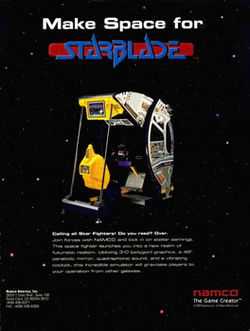Starblade
| Starblade | |
|---|---|
 Arcade Flyer | |
| Developer(s) | Namco Panasonic |
| Publisher(s) | |
| Composer(s) | Shinji Hosoe |
| Platform(s) | Arcade, Mega CD/Sega CD, 3DO, PlayStation, Virtual Console, iOS Devices |
| Release date(s) | Arcade
|
| Genre(s) | Rail shooter Space combat Light gun shooter |
| Mode(s) | Single Player |
| Arcade system | Namco System 21 |
| CPU | 2x 68000 @ 12MHz |
| Sound | 6809 @ 3MHz YM2151 @ 3.5MHz |
Starblade (スターブレード Sutāburēdo) is a 3D space-based rail shooter arcade game that was released by Namco in 1991. It was notable for its early use of real-time 3D graphics,[1][2] produced using the Namco System 21 "Polygonizer" arcade system board, and it is believed to have had a strong influence on the 1993 Nintendo game Star Fox.[2] Starblade was later ported to the Mega-CD and 3DO in 1994. It was also released on the PlayStation as Starblade Alpha in 1995. It also received a re-release in 2013 on iOS as part of the Namco Arcade application.
Arcade
The appearance of a "pod" in which the "gunner" controlled a double barrel laser cannon, was not a totally new concept in the arcades, but what was new was the method of how the image was projected. The arcade version of Starblade used a concave mirror (molded of black, reflective, and flexible plexi) to reflect the image from a 26" standard resolution monitor at the top of the simulator housing. This gave the player an experience of a deeper space environment which, with its lens like effect had never been seen in any video game at the time.
The player had a large and heavy 2-axis/4-button flight yoke controller which had a built-in red multi-LED lamp that flashed as enemies were destroyed. When the player was hit by enemy fire the seat would rumble and a two strobes (similar to photo flashes) would flash. A 30VDC motor with an asymmetrical axis produced the seat shaking effect as the seat module was mounted upon three rubber cylinders that allowed the seat certain movement.
The sound was a surround type system with four speakers: two in the front below the large mirror, and two in the back of the seat. The US version cabinet had the rear speakers tucked into its monitor-box at the top (behind the yellow plasitc cover where the grilles could be seen). The amplified audio signal was only a standard two channel stereo signal, but with a specially designed amplifier PCB which separates the audio into four individual channels.
Starblade was shown in Tekken 5 during the opening loading screen, and as an unlockable classic game in the Arcade History section in the game. Starblade also makes an appearance in Ridge Racer 7 as the wheels manufacturer and features varieties of wheels from the game.
Reception and legacy
On release, Famicom Tsūshin scored the both the Mega-CD version[3] and the 3DO version of the game a 28 out of 40,[4] giving the PlayStation version a 27 out of 40[5][6] and a 7 out of 10 in their Reader Cross Review.[7]
Enhanced ports
In the PlayStation (Starblade Alpha) and 3DO versions, players could choose from the arcade version of the game and an enhanced version. In the arcade mode, graphics are made of flat polygons and the playing screen contains little black bars on the left and right edge of the screen. For the enhanced mode, the games graphics are made up of fully textured polygons with a fullscreen view of the action.
Sequel
A sequel titled Starblade: Operation Blue Planet was developed in 2002, and ran in the Namco System 246 hardware. The prototype consisted of a Namco O.R.B.S. cabinet which used a projector on a globe-shaped surface and a "slide in" seat module. This setup was intended to fully immerse the player. However, it never made past field testing.
References
- ↑ Starblade at the Killer List of Videogames
- ↑ 2.0 2.1 "The Magic of Early 90s 3D". GameZone. 01. Retrieved 26 February 2012.
- ↑ NEW GAMES CROSS REVIEW: スターブレード. Weekly Famicom Tsūshin. No.307. Pg.40. 4 November 1994.
- ↑ 3DO GAMES CROSS REVIEW: スターブレード. Weekly Famicom Tsūshin. No.330. Pg.79. 14 April 1995.
- ↑ NEW GAMES CROSS REVIEW: スターブレードα. Weekly Famicom Tsūshin. No.329. Pg.32. 7 April 1995.
- ↑ PLAYSTATION CROSS REVIEW: スターブレードα. Weekly Famicom Tsūshin. No.333. Pg.24. 5 May 1995.
- ↑ 読者 クロスレビュー: スターブレードα. Weekly Famicom Tsūshin. No.335. Pg.30. 12-19 May 1995.
External links
- Review by 3DOkid (3DO version)
- Starblade at the KLOV
- Starblade at MobyGames